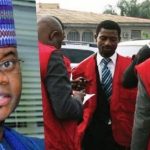Court Adjourns Hearing on Final Forfeiture of $8.4m, $7.4bn Linked to Patience Jonathan

A Federal High Court will on Jan.15, 2019 continue hearing on a suit seeking final forfeiture of about 8.4 million dollars and N7.4 billion found in bank accounts linked to a former First Lady, Dame Patience Jonathan.
The Economic and Financial Crimes Commission (EFCC), on April 20, 2018 secured an interim order for the forfeiture from Justice Mojisola Olatoregun in Lagos through an ex-parte (without notice) application.
In the suit, EFCC joined Patience Jonathan, Globus Integrated Services Ltd. and Finchley Top Homes Ltd. as respondents.
Also joined as respondents are Am-Pm Global Network Ltd., Pagmat Oil and Gas Ltd., Magel Resort Ltd. and Esther Oba.
Video evidence by the defence could not take place on Thursday as earlier scheduled because the court did not sit.
EFCC counsel, Mr Rotimi Oyedepo, had informed the court at the last adjourned date that he had an application for final forfeiture dated, May 8.
According to him, the application seeks an order of the court for a final forfeiture of the sums of money listed in the application.
He supported the application with an affidavit deposed to on May 20, by Mr Orji Chukwuma, an EFCC operative.
Oyedepo urged the court to grant the application for final forfeiture.
However, Mr Ifedayo Adedipe (SAN), counsel to the first respondent (Patience Jonathan), urged the court to refuse the application on the grounds that sufficient facts had not been placed before the court to warrant a final order.
According to Adedipe, the applicant’s case is that it found money in the accounts of the first respondent, which it suspected to be proceeds of unlawful activities.
He argued that the first respondent was neither invited by the EFCC nor prosecuted.
Adedipe argued that the applicant (EFCC) failed to take the preliminary steps but headed to seek an order of forfeiture.
The counsel said that the practice fell short of prosecutor procedures.
He argued that the depositions by the applicant that the funds represented proceeds of unlawful activities had not been substantiated, noting that Section 36 of the Constitution provided that a person should not be convicted of an offence, unless defined and punishment prescribed.
According to him, there is no crime known as “statutory suspicion”.
He submitted that the onus rested on the EFCC to prove that the respondent had such amounts of money, and that they were obtained under false pretences or fraud.
He said that although there were depositions that the funds were obtained from “Women for Change” and Bola Shagaya, there were, however, no evidence before the court to show that the funds were stolen.
He submitted that the application was vindictive, urging the court to dismiss it.
Also, Chief Mike Ozekhome, counsel to the third, fourth, fifth and sixth respondents, argued that the application was premature when judged by the provisions of the Advanced Fee Fraud Act.
Ozekhome said that the affidavit of the third respondent (Finchley Top Homes Ltd.) to show cause had not been taken.
According to the counsel, it is when same has been argued and the court finds no merit in it that the EFCC can be justified and better placed to bring the application.
He submitted that the third, fourth, fifth and sixth respondents filed affidavits to show cause.
The counsel said that exhibits labelled F1 to F6 were attached to the affidavits.
He said that the exhibits confirmed that the third respondent was a company, showed its certificate of incorporation and its board resolution that Patience Jonathan be made a signatory to it.
He added that the affidavits showed bank document indicating that the company’s account was signed by other persons who were also signatories.
Ozekhome also told the court that the third respondent made money from selling groceries, drinks and other items, adding that exhibit F5 showed video evidence of various outfits, legitimately run by the third respondent.
He prayed the court to allow the video exhibit to be shown in the court.
According to him, Exhibit F6 are manuals, catalogues and handbills indicating the ongoing legitimate concerns of the third respondent.
Ozekhome made similar arguments for the fourth, fifth and sixth respondents. (NAN)







